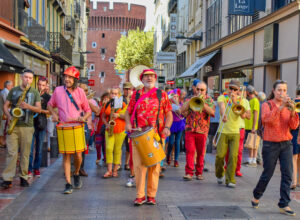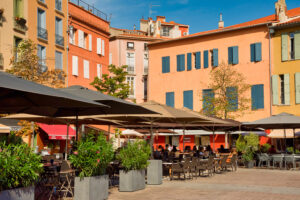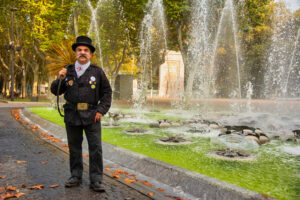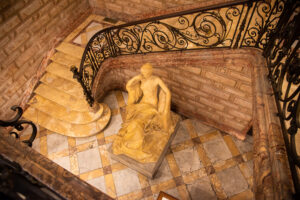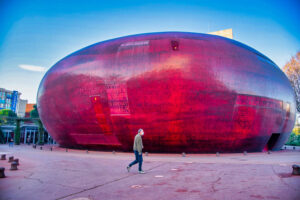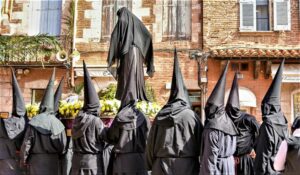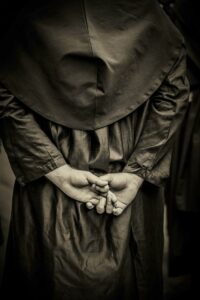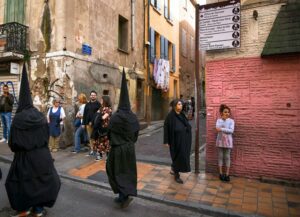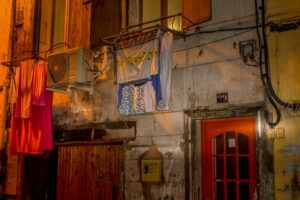By Ava Kabouchy – Photography & Travel Website
When Ava Kabouchy took the plunge and exchanged the Atlantic temperatures of Maine for the Mediterranean temperatures of southwest France, she also gained a completely different colour scheme. Based in Perpignan, she spent 3 years in this multi-cultural city and discovered the many layers of French culture and history.
Follow her, as she takes us through this both French and Catalan city and shows us its vibrant beauty.
I had never heard of Perpignan until I decided to spend my first nonworking year relearning French somewhere in France. I looked at a map of France online and my eyes went to the south, looking for a warm climate and I saw the name “Perpignan”. Then I looked at google images of Perpignan and saw palm trees, blue skies, and the emblematic Castillet, the city’s medieval gate, and my decision was made. Called by some the second sunniest city in France, Perpignan has 250 days of sunshine, and its own micro-climate. It might be overcast and grey in Toulouse, only a two-hour train ride away, but the sun will be shining in Perpignan.
Off I went to the University of Perpignan which offered reasonably priced, full-time courses with the possibility of a homestay. I landed with a retired French couple – the husband was a chef. My great good fortune! I enjoyed a variety of French dishes every evening, once including frogs’ legs once, and once for me. When my son asked me what I had to do within the family, I answered, “Well, uh, I have to make my bed in the morning.” No housework, no laundry, no cooking. I studied French with excellent professors, one of whom successfully spent eight hours on the study of the subjunctive mode in the grammar class and made it interesting, no small feat. So, my non-working years started with just studying and enjoying my new surroundings, the city’s medieval history, a compact city with its café culture, where all the attractions can be walked to, glimpses of Catalan and Gypsy culture, and a bus costing one euro to Collioure on the Mediterranean, an easy day trip. I had planned to stay in Perpignan just for the year. I stayed instead for three. Why leave?
When you visit Perpignan, you will not see any of France’s famous monuments, but you will see colours and more colours. Photography has been a passion of mine for a long time, and not noticing Perpignan’s vibrant colours would be impossible. Colours everywhere! The blue skies, the pastel colours of the architecture, the bricks of the Castillet, the garnet shaped theatre, L’Archipel, a vibrant red inside and out, designed to symbolize the area’s garnet industry, the fresh vegetables and fruits of the Casanyes Market.
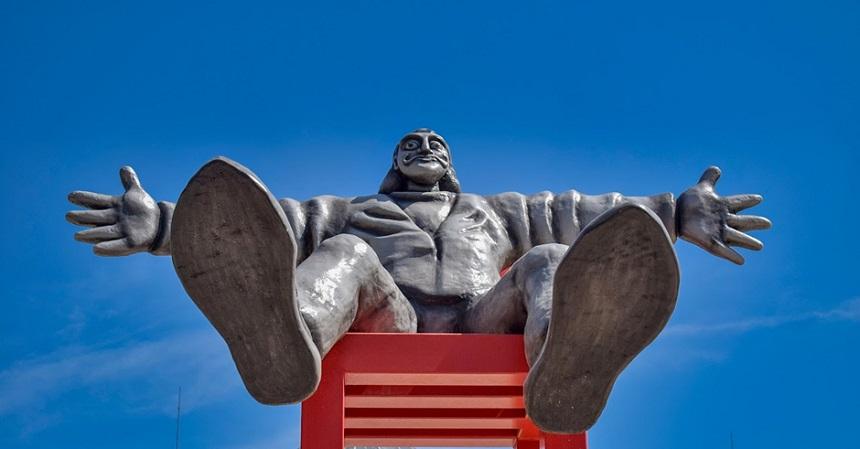
Salvador Dali, who called Perpignan in Catalan, his native language: “el centre du mon“, “the centre of the world”, caught some of those colours, such as the one he painted of the Perpignan train station. You will experience Catalan culture and its spicy cuisine along with cuisine of southwestern France, a variety of dishes made with duck and many others with mussels and other seafoods. You will sample some of France’s finest wines from nearby Collioure, whose rocky, dry soil and steep, southern exposed hills create intense, full-bodied wines.
For Lovers of History
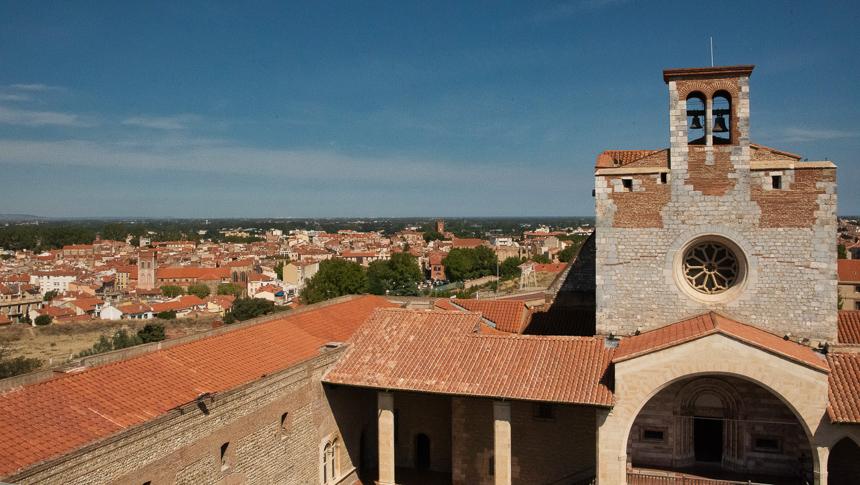
If you are history buff, seeing the Palais des Rois de Mallorque, the Palace of the Kings of Mallorca, will intrigue you with its medieval history and immensity of its gothic architecture. The Palace was begun in 1274 as a fortress by the first King of Majorca, King Jaime II, who wanted to protect Perpignan’s growing prosperity. It is believed that Perpignan was settled around the beginning of the 10th century and became a commercial centre for the Roussillon region at that time.
The Musée Hyacinth Rigaud will delight you with wall size paintings of Louis XIV and even of the Sun King’s mother. Hôtel Pams, not a hotel but a mansion built between 1852 and 1872, was built by Pierre Bardou, who made his fortune by manufacturing cigarette papers, now owned by the city of Perpignan and open to the public.
New Surroundings, New Experiences, All in Vibrant Colour
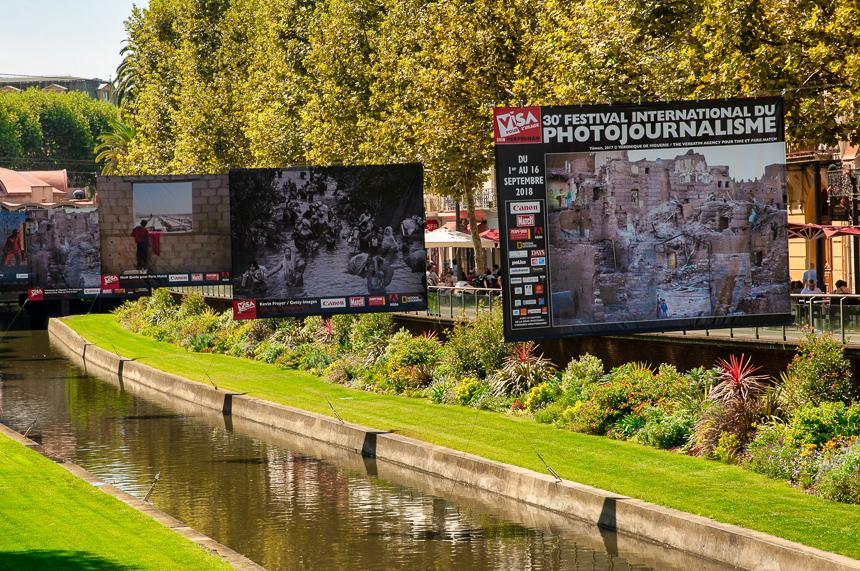
Each September, Perpignan hosts an international photojournalism festival Visa Pour L’Image, showcasing reported and unreported news events around the world. The festival brings light to environmental problems around the world, how countries may or may not be addressing them, and the consequences of governmental inaction. It also highlights cultural practices, anything from weddings to the lives of nomadic tribes, senior women playing a game of basketball on one wall, and the harsh treatment of prisoners on another.
Surprises Around Every Corner
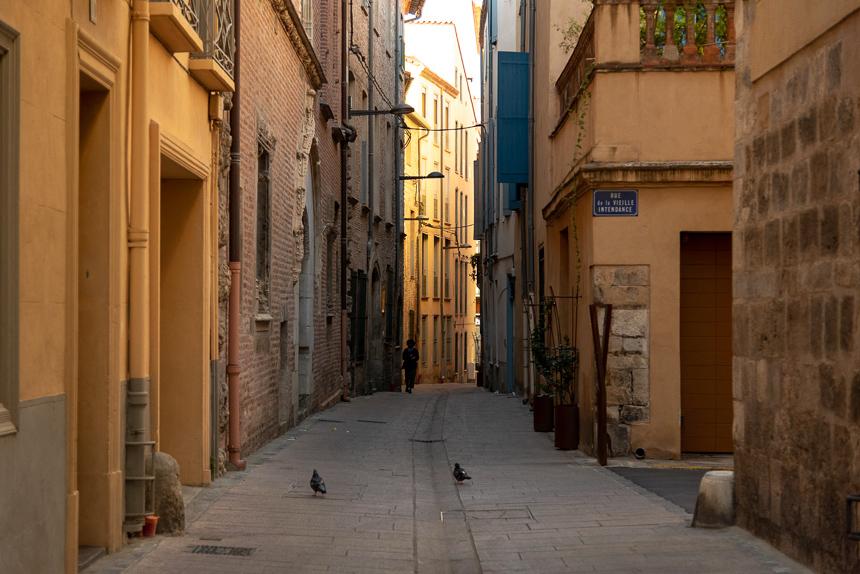
As you walk along Perpignan’s medieval streets, you may be surprised by what or whom you see. The city’s narrow streets attest to the summer’s heat, as the buildings were constructed close to one another, creating cooling shade.
Cuisine for Everyone’s Tastes
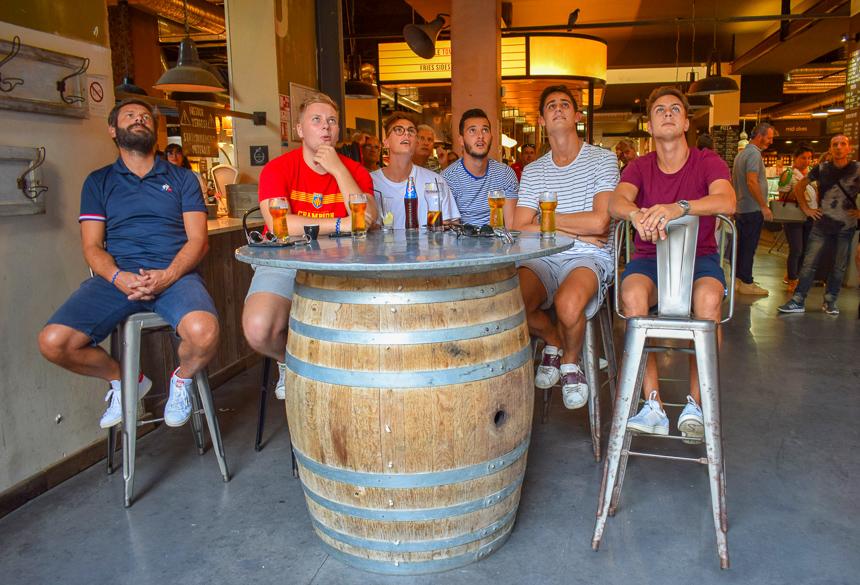
Along the Canal Vauban, which runs through the centre of Perpignan and is bordered by cafés and retails shops, you will also find Les Halles, an indoor market, which opened in 2017. Even before entering the large market area, you will be tempted by an assortment of gelati and French pastries at the entrance. Entering the main area of Les Halles, however, you might be overwhelmed by the choices awaiting you – which of the 27 stands to visit to purchase fresh fruits, meat, fish, oysters, shrimp, a huge assortment of olives and dried fruits, cheese from the Pyrenees, regional wines, and craft beers. Or you can choose among several restaurants and enjoy the cuisine of Morocco, Lebanon, Portugal, Catalonia, or just a well-made American cheeseburger.
Les Halles is most often crowded weeknights and weekends and there is an outdoor seating area and if you are early enough, you’ll find a comfortable sofa where you can sit and enjoy your meal with a glass of wine in the convivial atmosphere. You might even be able to learn to dance the tango or watch a football game with some local residents.
Cathedral of St. Jean the Baptist and the Flag of Catalonia
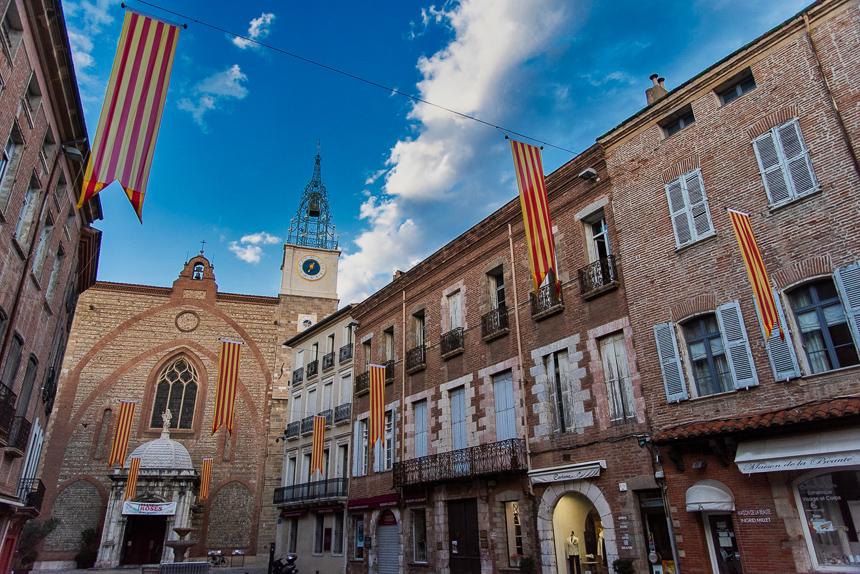
The 14th century Saint John the Baptist Cathedral built in gothic style architecture with one
central nave is in the centre of Perpignan. Catalan culture and history are part of the history of this region of France, Roussillon. The red and yellow Catalan flag, symbolizing blood and battlefields, can be seen in numerous places in Perpignan and across the region.
Celebrating Perpignan’s Medieval Past
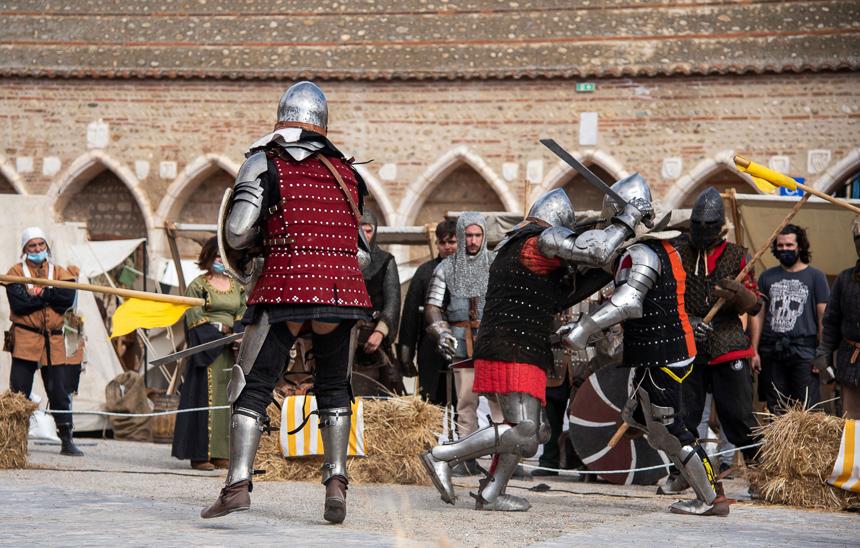
Next to the cathedral is the cloistered cemetery, Campo Santo, where a medieval village is recreated once a year with singing troubadours, music and dancing, knights in combat, and demonstrations of forging, leather crafts, and pottery making.
Casanyes Market – Off the Tourist Track and Well Worth a Visit
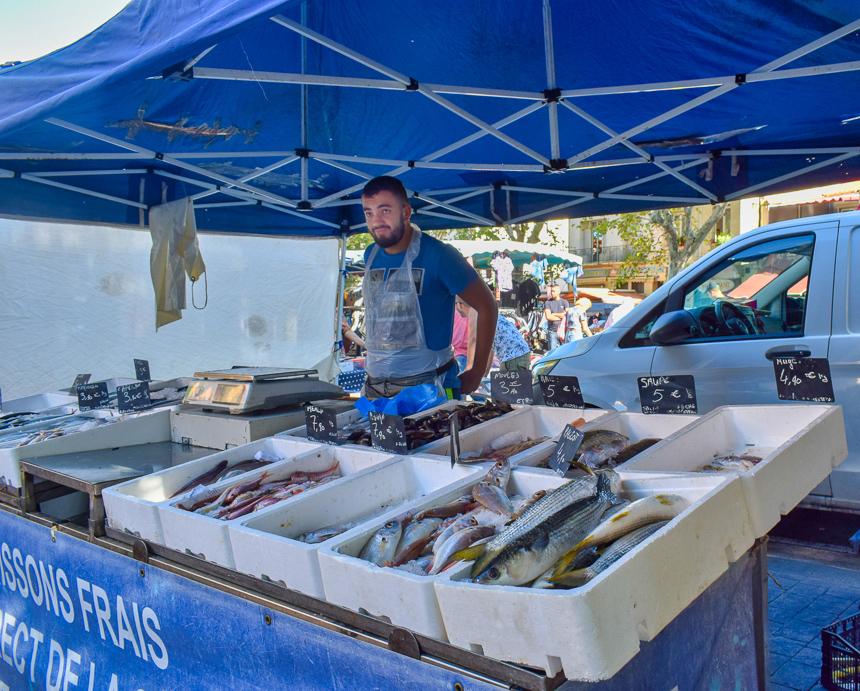
Open air markets can be found all over France. They make up much of the culture of towns and villages and are a social gathering place as much as a place to do one’s daily food shopping. If you are an early riser, you will see women and men setting up their stalls of fresh fruit, vegetables, huge platters of paella, olives, dried fruit, inexpensive clothing, jewellery, makeup, and a variety of every household gadget imaginable.
The meat markets are all halal, well stocked, organized, and clean. Fresh fish from the nearby Mediterranean is available every day. The market is open each day from 7AM to 1PM, and it is not just what you’ll find in the market, but also the people that you will see and hear – friendly women calling to customers, promising the best prices.
Some will even give you an extra carton of blueberries or whatever fruit you may be buying. I remember filling my bag with a variety of fruits and vegetables and when I handed it to the merchant to pay him, he looked through my bag and asked me for 6 €. The price would easily have been double in any supermarket and without all the conviviality of the Casanyes Market.
Two Distinct Cultures Living Side by Side
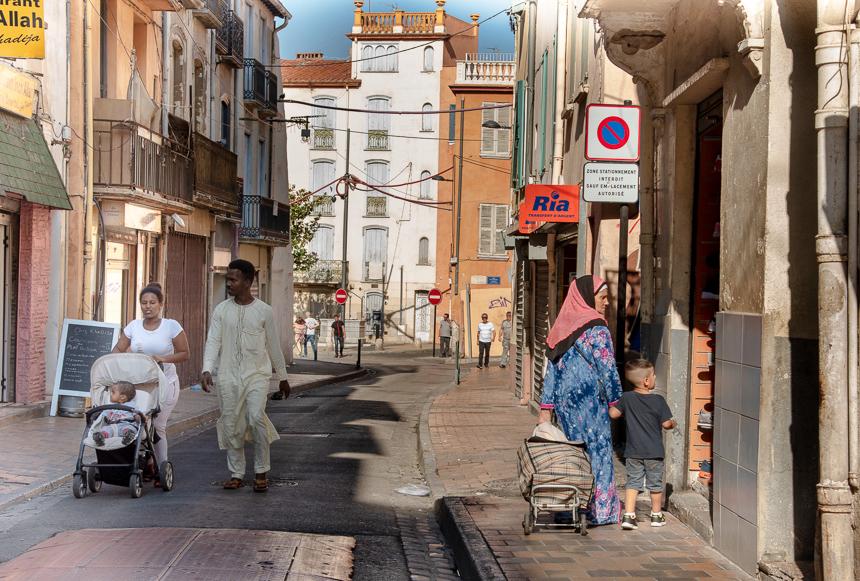
What makes this market unique from others, however, is the mingling of two very distinct very different cultures: Gypsy and North African. The Casanyes Market borders the St. Jacques neighbourhood. which had been a Jewish enclave for many years until around 1940 when the Gypsy community began moving in along with African families.
The two communities, Gypsy and North African, are often at odds and violence erupts from time to time, but they do agree on one important point – they will not allow the government to demolish the neighbourhood as it has proposed doing even with the promise of better housing. Not only the Gypsy and North African communities, but local people as well who wanted to preserve the neighbourhood were also joined by an assortment of local middle-class groups who were keen to preserve St Jacques’ architecture and cultural atmosphere.
Talks to make the neighbourhood a UNESCO site continue. These facts, however, do not hide the realities of life in St. Jacques. Unemployment is very high – some estimates put it at 90% and public assistance is the norm. School attendance is not a high priority for some Gypsy families, creating future problems for the children who reach adulthood with minimal reading and writing skills. Health is poor among many because of a diet of processed foods, resulting in obesity and other health problems.
“Work”, he told me, “We Need Work”
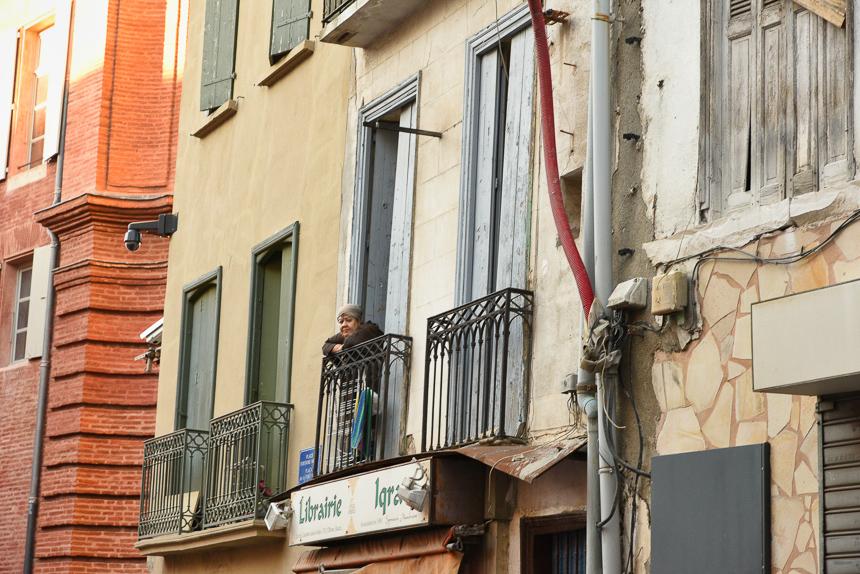
My French host family has a young Gypsy man as part of their family as he is the father of two of their great grandchildren. This young man and I had several conversations during my first year in Perpignan and he told me of the many difficulties he faced growing up in an impoverished family, and being unable to find work because his Gypsy background is looked down upon by many potential employers, adding to the limited schooling he had as an adolescent. He emphasized the need for work among the young people of his community and how near to impossible it is to find it. Problems of drugs and violence have found no solution.
A Lively Though Disenfranchised Community
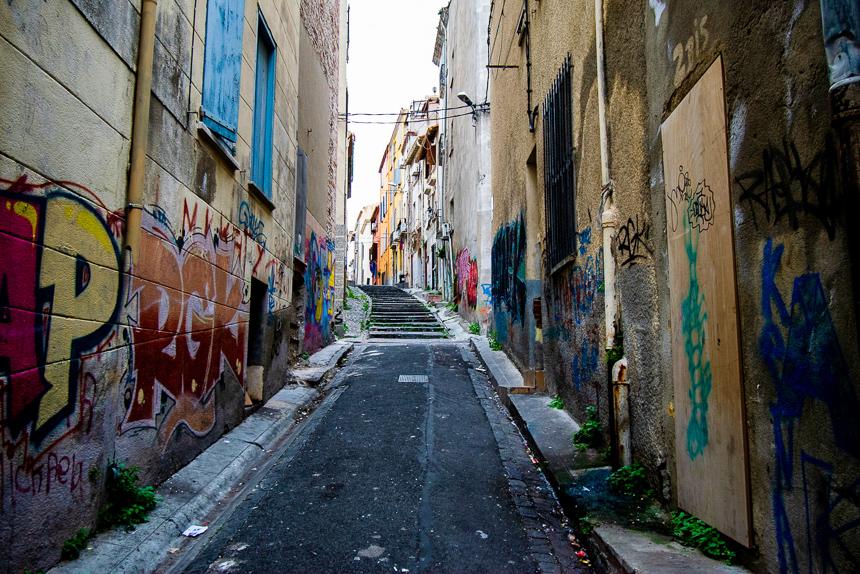
The St. Jacques neighbourhood seems to wake up about 4PM when people congregate outside, children running everywhere, music being loudly played. Often as I passed entrances into the homes, I glimpsed unlit, narrow staircases and wondered what life is like for this community, the hardships it must face on a daily basis, and yet the people stay. Family ties are very strong.
Among the Gypsy community, there is a palpable sense of community and togetherness. A young woman is never seen walking alone within St. Jacques nor in the centre of Perpignan; she is always part of a group of friends, often going into town to the discount clothing store – and they are closely surveilled. These young women are easily recognizable, almost always dressed in black with their long, black hair piled high upon their heads.
The neighbourhood is not clean and is called unsafe by many. Trash and debris line the curbs. I had been warned many times not to walk through St. Jacques at anytime of day or night, but the colours, sights, and sounds were too intriguing for me to bypass – walls covered in colourful graffiti, people of all ages sitting outside on ragtag sofas and chairs, music playing, laundry hanging from front windows day or night. Not once, even late at night, however, did I ever feel threatened. One night, in fact, upon seeing my camera, two young Gypsy cousins came up to me and asked me about it, nothing more than that. We talked for a while about school, what they were studying, and how much they enjoyed playing football. And then I walked safely home
The Sanch: Procession of the Penitents
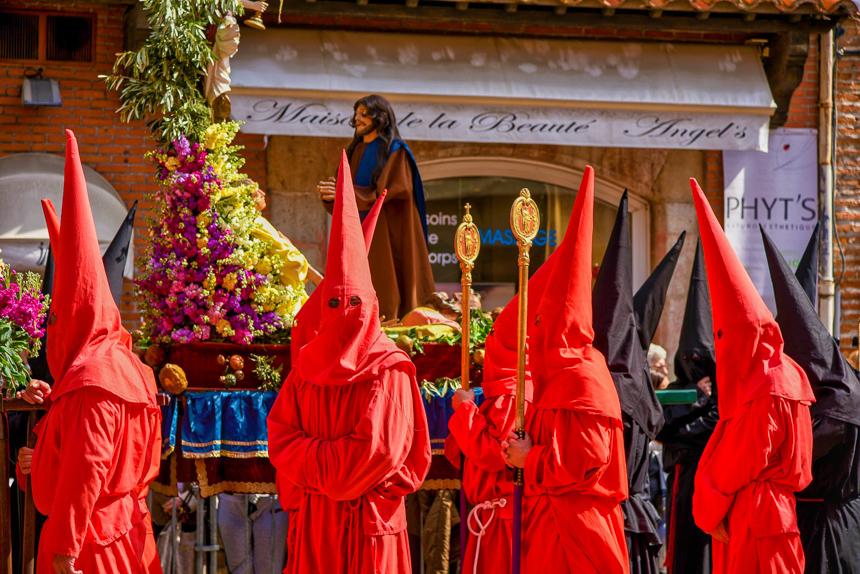
If you are in Perpignan on the Friday before Easter, you will see a tradition, which may take your breath away, dating back to 1416 when a Dominican priest, Vincent Ferrier, likened the suffering of Christ to the way criminals were treated at the time. One of his sermons on this topic resulted in the identity of executioners and condemned men being hidden to keep the condemned men from being identified by angry families, who might have taken justice into their own hands. Over the years, the procession of condemned men evolved into La Sanch, meaning The Blood, to commemorate the crucifixion of Jesus, and for many years, was forbidden by the Catholic Church as immoral, but La Sanch persisted and continues until today.
Peaceful Demonstrations
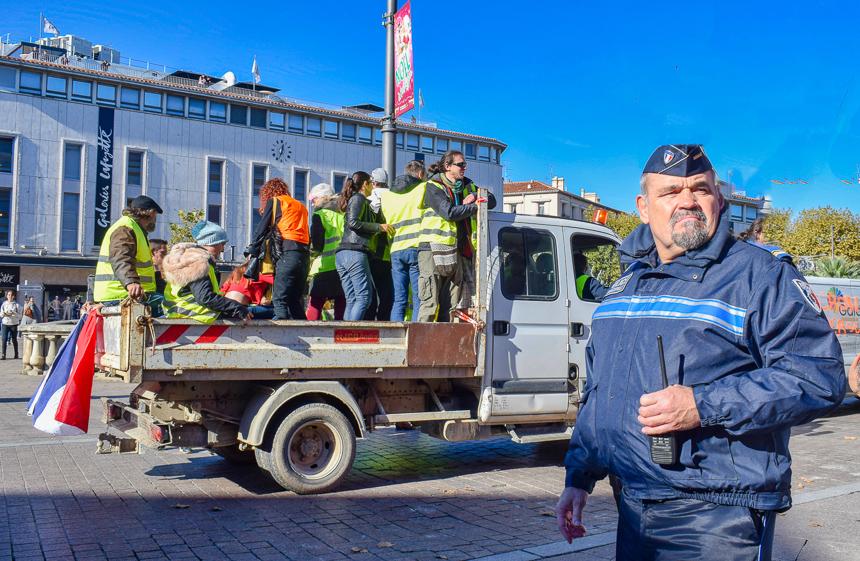
The violent protests in France beginning in November 2018 against proposed rises in gas and fuel prices were widely reported. People supporting and taking part in the demonstrations wore gilets jaunes, yellow vests, which became the symbol of the movement. Paris was the hardest hit, where businesses, cars, and stores along the renowned Champs Elysée’s were torched and vandalized.
During the three years I spent in Perpignan, I witnessed several political demonstrations, not one of which was violent – one for higher salaries and improved working conditions for teachers, another for the rights of immigrants, and one by the gilets jaunes, the yellow and vests and their demands.
One morning near the Castillet, I happened upon a large number of men and women dressed in workers’ blue uniforms performing an anti-Macron song and dance routine to protest the proposed changes by the French president, Emmanuel Macron, to current government retirement policies. The atmosphere was clearly festive – no shouting, no hint of violence, just a group of people letting the government peacefully know how they felt, and letting the government know their feelings by singing and dancing.
Late one morning when I was in Perpignan centre, I heard car horns beating in rhythm and I waited to see what was happening, thinking that a well-known person or politician was in town, possibly Marine Le Pen, a political conservative with ambitions to become the next president of France, who might have been visiting politically conservative Perpignan. But the horns weren’t blowing to welcome anyone famous, but to announce that the gilets jaunes were coming through. The feeling was that of a party or festival, not at all unlike the dancers singing and protesting President Macron’s proposed policy of changes in retirement laws.
People were waving to the gilets jaunes, showing support in the way that so many things are done in Perpignan – joyfully and with much laughter. Later that day when I was back with my host family, we heard motorcycles, one after the other, passing in front of the apartment. Once again, the gilets jaunes, hundreds of them on motorcycles were passing by. Residents, including my host family and myself, went out onto the balconies to cheer them on and wave to our neighbours.
Take the One-Euro Bus
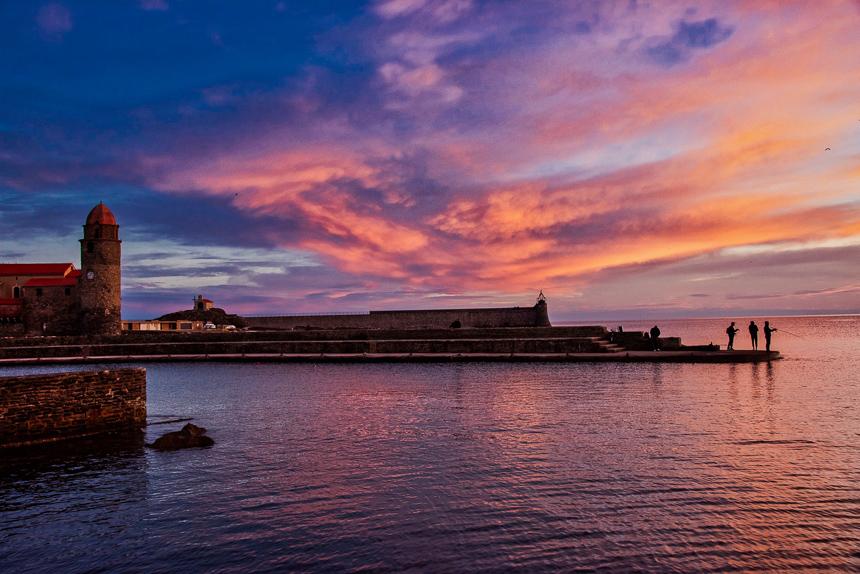
Perpignan boasts about being only 20 minutes from the Mediterranean coast, and particularly from the colourful, Catalan town of Collioure, where anchovies are caught, processed, and sold. Easily reached by car, but you can also take the one-euro bus, which will drop you off around the corner from the 14th century Château Royal overlooking one of Collioure’s beaches.
Hikers can walk along the Sentier Littoral, the coastal trail, as I did one day in a January and viewed the Mediterranean on one side and the Pyrenees on the other, with its snow-capped peak Canigou, 2,875 meters, almost 9,000 feet. By chance in one afternoon in a January, the temperature had reached 26C, 79F, much appreciated by someone like me from Maine or anyone looking for a bit of winter warmth.
The wines of Collioure are well known through-out France because of the unique dryness of the white wines made from grapes grown in dry, rocky soil on high, south-facing slopes overlooking the Mediterranean at an incline of 50%. Having driven past these slopes or hiked above them in the Alberes Mountains, I have wondered how people manage to harvest the grapes on such steep land, but they do, and the delicious wines whether white, red, or rosé are proof of their labour. So much about Roussillon is about colour, and in Collioure, you will find homes painted in pastel colours, paint left over from the paint of the fishing boats, and a summer festival celebrating Catalan music and culture.
A Vibrant City Not to be Overlooked
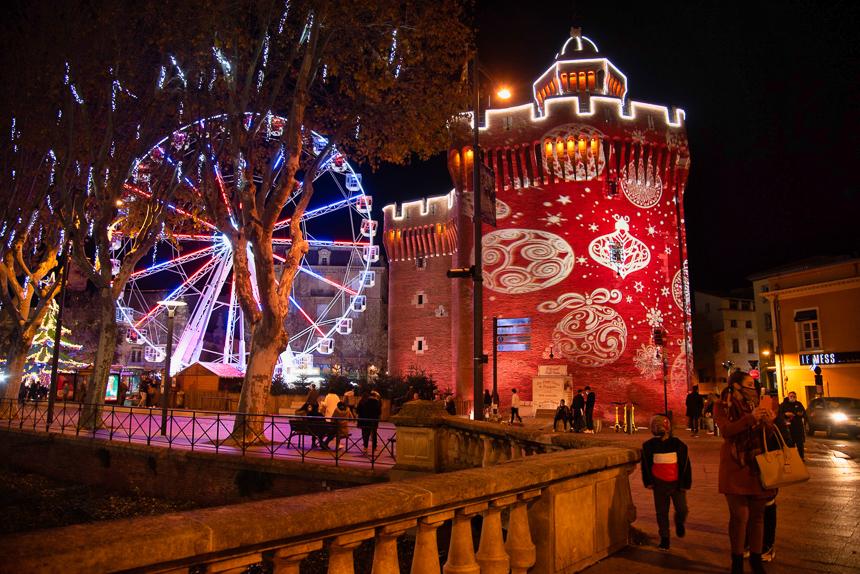
Perpignan is a small city, one for all seasons, one from which there is no exodus in August as there is from Paris or from the Dordogne region where large numbers of expats leave in January and February looking for warmer climes. Theatre, cinemas, wine tastings, open air markets, and just a simple stroll through the city’s winding streets will always give you something to see and to do, something to enjoy, something new to learn, something to celebrate.
Getting there
Barcelona’s El Prat is the nearest international airport. From there, you can take the metro for 4 euros or a taxi for about 25 euros to Sants train station. The trip by train takes about one and a half hours, and the train goes from Barcelona to Perpignan three times a day. Regular flights and trains leave from Paris as well.
Where to stay
Hotel de la Loge is located right in the centre of Perpignan, across from the tourist office where the English-speaking staff will help you with tour arrangements and which sites to visit. Hotel de la Loge is a favourite among visitors to Perpignan and is located on one of the city’s typical narrow streets, and the setting is quiet.
Where to eat
My reaction to this is – anywhere and everywhere. All kinds of cuisine can be found in Perpignan and among my favourites is L’Arago on the Place L’Arago, a short distance from Hotel de la Loge. A very pleasant outdoor seating area is available and there are many delicious choices on the menu.
About Ava Kabouchy
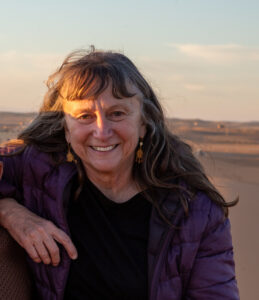 As a child, Ava was fascinated by world maps, which later turned into travels to many parts of the world. She has worked in several African countries, created a microcredit group for women in Honduras, and did a volunteer photography gig for a clinic for a Mayan community in a remote mountainous region of Guatemala. Recently, she hiked along the Camino de Santiago in Spain and in France, travelled in Morocco, fulfilling a childhood dream of walking barefoot in the Sahara and another of seeing the aurora borealis in Iceland.
As a child, Ava was fascinated by world maps, which later turned into travels to many parts of the world. She has worked in several African countries, created a microcredit group for women in Honduras, and did a volunteer photography gig for a clinic for a Mayan community in a remote mountainous region of Guatemala. Recently, she hiked along the Camino de Santiago in Spain and in France, travelled in Morocco, fulfilling a childhood dream of walking barefoot in the Sahara and another of seeing the aurora borealis in Iceland.
Ava is the author of the recently published “Where in the World is Grammie Now?”, a book for young readers to teach them about Saudi Arabia, a country not often studied in middle school curricula. She has also authored a book on her four years in Saudi Arabia: “Wanderlust, A New Lease on Life in the Kingdom of Saudi Arabia”.
Ava makes her home in southwest France and on a remote island off the coast of Maine, USA.
Find out more about Ava Kabouchy on her website.
